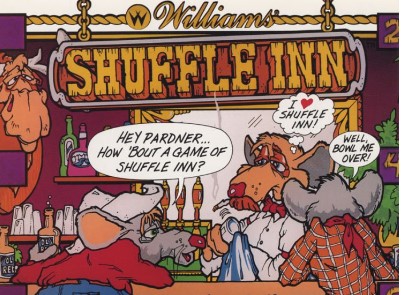
The evening is just getting started. You and a couple of friends are headed to the corner bar to grab a drink and maybe chase the silver ball. Heading in, you begin the hunt for the amber incandescent glow of a Silverball Mania or maybe that Evil Knievel your buddy set the high score on last week. Then you see it… Seems the bar pulled an old twelve-foot shuffleboard out and backed a new monstrosity in. A long shelf-like structure reaches out and waiting patiently is a stainless-steel puck twice the size of the one you played on the old shuffleboard. Just the one. Bowling lines and arrows remind you of a bowling alley. Yet the back glass is Pinball like and familiar. You plunk in your quarters, queue up the plays, and slide the steel across the silicone-sanded surface under the suspended bowling pins as the soft thud of the rubber bumper kicks the steel back. The resulting split reveals you’re as bad at shuffle bowling as you are at real bowling.

Compact (compared to a real bowling lane) shuffle alleys were developed by some of the best early pinball game designers going back to the electromechanical age. These games by Chicago Coin, Williams, Bally, and United to name a few allowed pinball operators to push into smaller bars and pier-side arcades where the gambling stigma of early pinball had previously excluded them. Many locations jumped at the chance to compete with the new surge of bowling alleys without having to invest money and space into an automated pinsetter– a massive undertaking in 1951 when United released the titular Shuffle Alley.
With steady production over the next 40 years, many new gameplay innovations were added to the versatility of these hardy machines making them able to stand beside standard 10 pin bowling. Game modes aside, the overall body design has remained the same until the addition of monitors and optical sensors in the mid-’90s. There is still a long bowling alley lane lined for the puck to slide. As it glides, switches are embedded in the field under the pins which fold up on armatures to simulate being knocked down.

The number of these games out for public play tends to be limited. The very nature of the gameplay often means these machines have taken a beating. Combined with a need to have the playfield sanded regularly with specialized wax-coated silica that can make or break the gameplay, and that means, outside a private home, the chance to play one in full working condition can be a rare treat. If you see one, try one! As a matter of fact, there’s Williams SHUFFLE INN at Reboot Retrocade & Bar right now! Interesting and innovative, you’ll be surprised how accurate a few mechanical switches can be at tracking a puck’s path to picking up a spare. Or catching just the right outside edge to kick over for the split!

